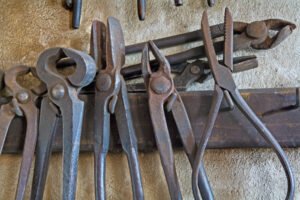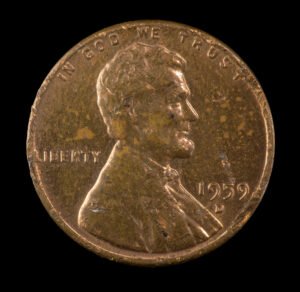We know that aged, designer chairs are worth collecting. But do you know that even old rocking chairs are a strong attraction for antique collectors? Yes, these vintage swing chairs build a fortune, but only if they’re really ancient!
So today, I brought a detailed antique rocking chair identification guide to help you easily spot an authentic vintage rocker and estimate its average cost! Let’s get into it!
Key Takeaways
- If you’re looking for old, handmade chairs, get Solid-wood, Boston, or Mission-style ones. And you can look for a curved or mesh body with Shellac for a handmade touch.
- New metal or steel chairs are thin and cheap. So, pick Walnut, Mahogany, or Oakwood chairs for good returns up to $500.
- If you want branded chairs, get the ones with crude wax, oil, or milk finish. And you can also check for stamped logos or fabrics to raise the valuation by 2 – 3%.
- If you don’t want typical garden chairs, get American, Victorian, or Art-Deco chairs for traditional decor.
What Do Antique Rocking Chairs Look Like?
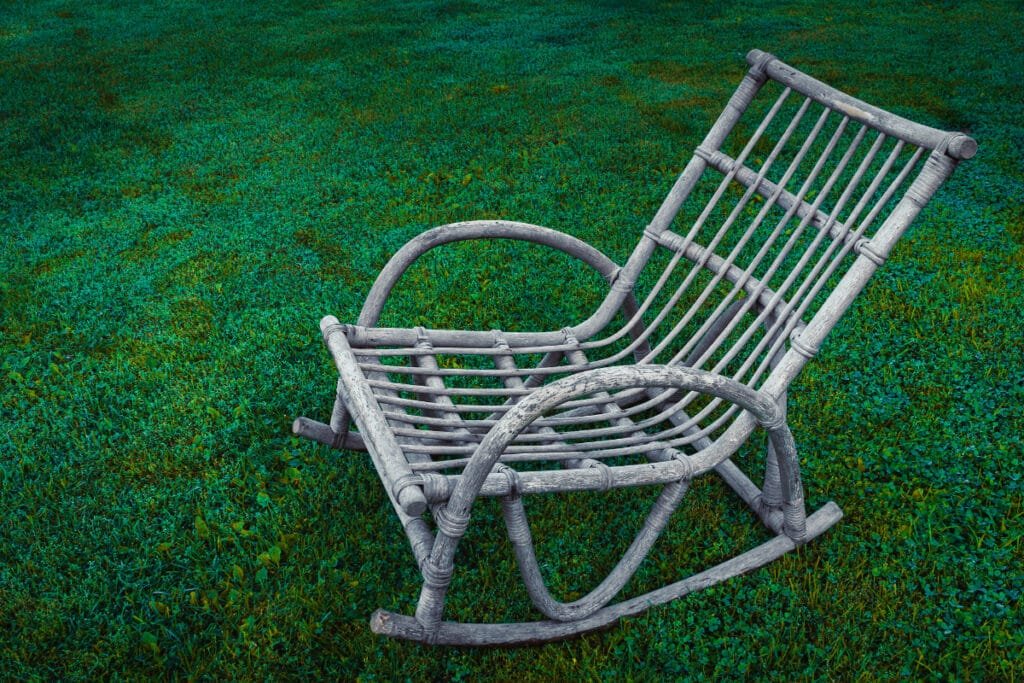
Most rare rocking chairs have an oak construction and hand-made joints with peg legs. They also have curved backs and carvings that elevate their aesthetic and valuation.
If you’re still not sure, look out for these features to identify antique chairs:
- Simple Oak, Walnut, or Mahogany sections with a Shellac finish
- Rough glue and peg joints with square nails
- Curvilinear body and floral or mesh inlay designs
- Burnt or carved logo and a trademark that helps track the age
- Spindle or turned legs and a thicker square or rectangular base
- Glued or stapled upholstery with shiny metal or brass pushpins
The History & Evolution
The first rocking chair popped up in the 17th century. And since people used them outdoors, they had solid wood legs and backs to withstand the weather. These chairs had handcrafted armrests with chips and tool markings.
But manufacturers started using thin forms and hoop backs in the 18th century. So, the rocking chairs became more comfortable to be used indoors. But they had uneven surfaces, leaner legs, and a waxy finish to save them from heat and humidity.
Then, America witnessed an Industrial Revolution in the 1870s. Rockers were then factory-made with thin, ornate designs and a better stain. With curved armrests, spindles, and embossed logos, such old rocking chairs are highly precious today!
Types of Antique Rocking Chairs
When identifying an old rocking chair, it’s important to learn about the six types of antique rocking chairs. So, let’s discuss those types to identify and value the chair better!
1. Bentwood Rocking Chair (1800s – 1850)
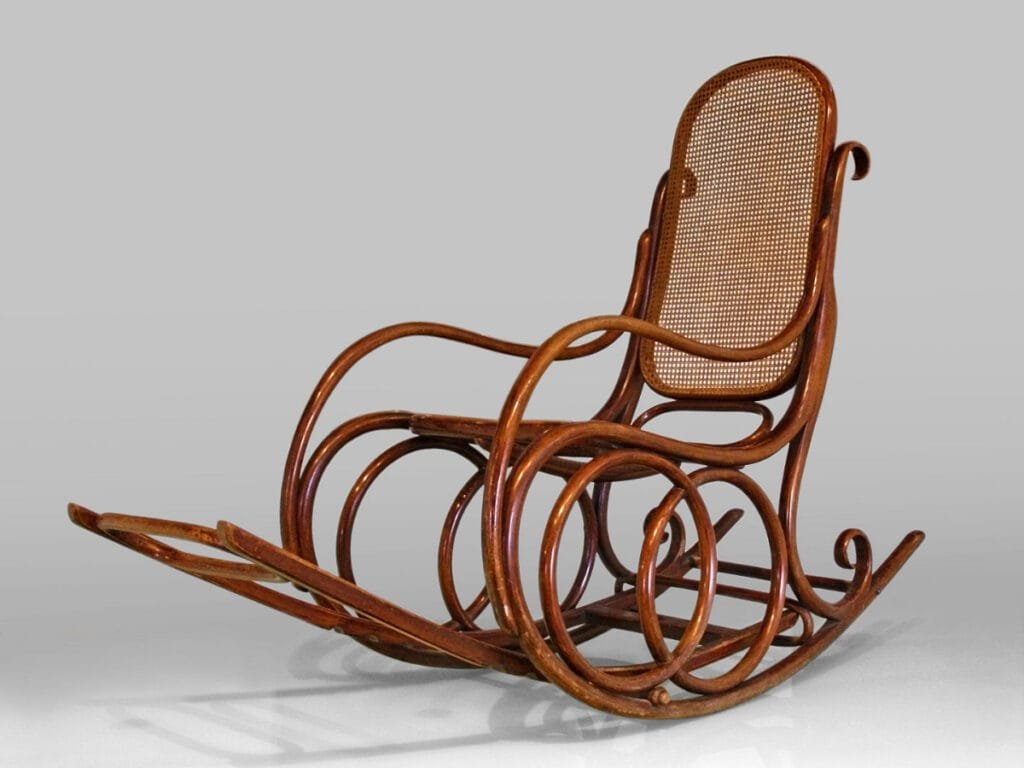
Bentwood chairs are beechwood chairs with spiral legs and curved rockers. They are very lightweight and may have cane backrests and seats. Generally, old bentwood chairs are brown or white, but newer ones may be black or silver too.
But, these rocking chairs are brittle and need proper lubrication for durability. So, they have a moderate valuation of $100 – 250.
2. Boston Rocking Chair (1830 – 1890)
A Boston rocking chair consists of sturdier oak or pine sections. These chairs may have floral carvings at the sides but have curved seats and backs for better comfort. They are usually black but can be brown or brass-colored, depending on the age.
Boston chairs are relatively newer but expensive due to their solid wood seats and headpieces. So, you can expect a valuation of $350 – 500 for new chairs and $500 – 750 for old ones.
3. Folding Rocking Chairs (1870)
Folding rockers are lighter metal or wood chairs with hollow backs and leather seats. They are easy to store but are very brittle due to the moving parts and joints. So, depending on the material, they have a lower valuation of $70 – 150.
4. Ladderback Rocking Chairs (1850s)
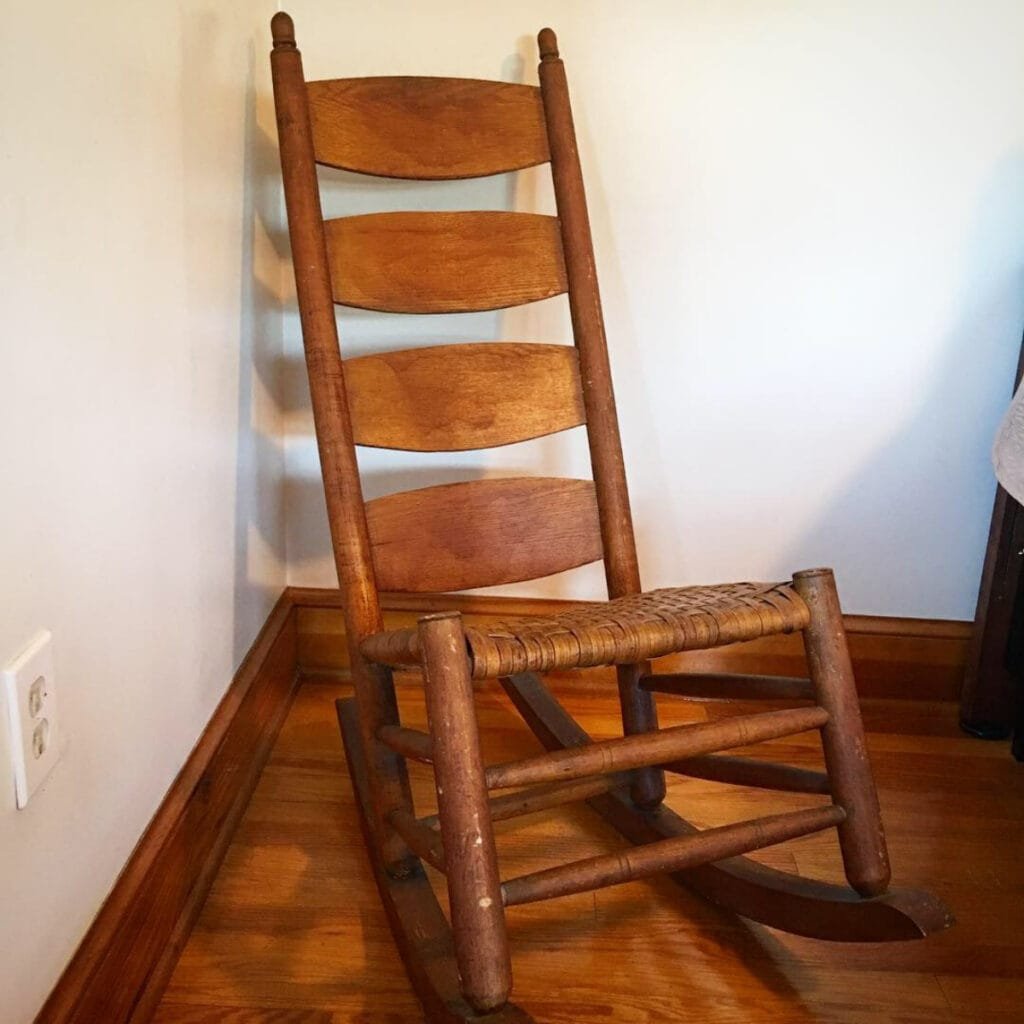
Ladderback rockers are sturdy, upholstered chairs with horizontal slats at the back. They are pretty tall, with 2-3 extra footrests at the base. These chairs are mostly white but can be available in black or brown, depending on the brand and region.
But since they are new and factory-made, they have a lower valuation of $50 – 60 at any auction.
5. Mission-style Rocking Chairs (1870s)
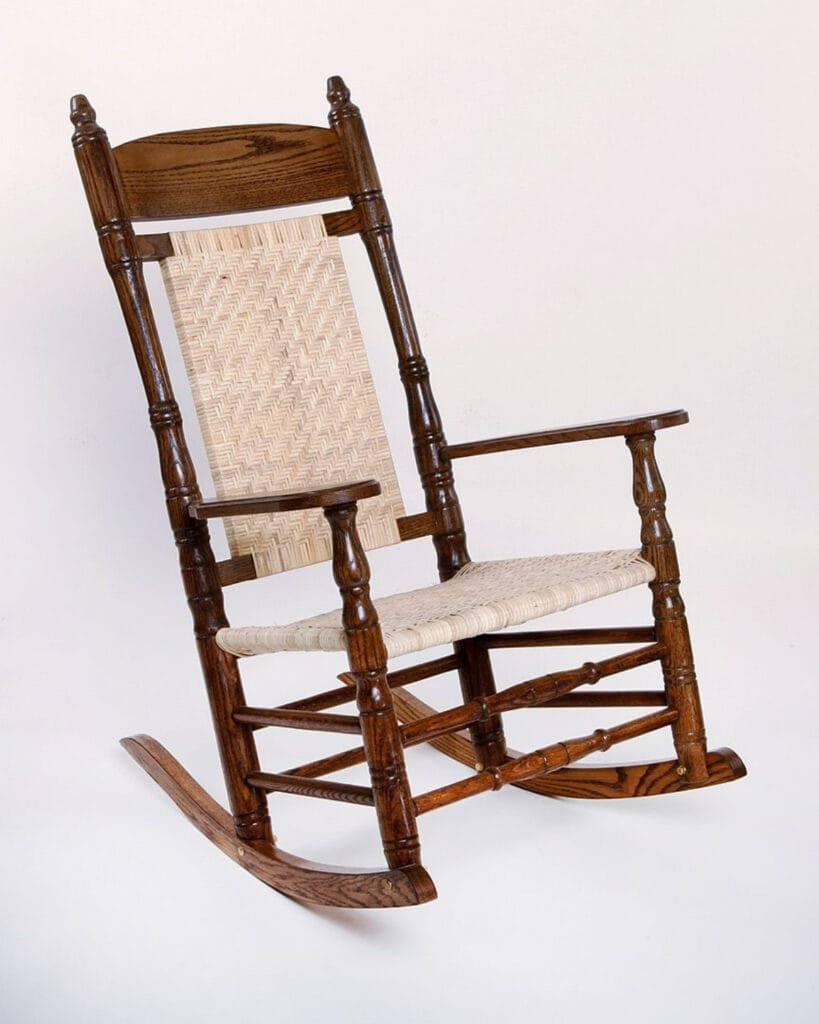
Mission-style chairs use square or squat sections with a linear, planked frame. They don’t have any ornamentation but have elegant wood stains and solid finishes that hike the cost. And since they use seasoned, hand-screwed joints, you can value them up to $500.
Mission rocking chairs are further classified as follows:
- Windsor Rocking Chair: These are thin, tall chairs with spindle backs and armrests. They do not have carvings but may have painted fruits and flowers. So, they have a high valuation of $500 – 700.
- Sewing Rocking Chair: These thin, feminine chairs have low backs and armrests, valuing $150 – 200.
6. Platform Rocking Chairs (1900s)
Platform rocking chairs have a stationary base but use a springed seat to rock the user. The chair remains flat on the ground, reducing friction and floor damage. But, its unstable seats and brittle parts lower its valuation to $100.
9 Factors to Identify an Antique Rocking Chair & Value It Correctly
Old rocking chairs have varied materials, brands, colors, etc., that decide their possible cost. Let’s explore all the factors that affect the antique rocking chair value:
1. Rocking Chair Age
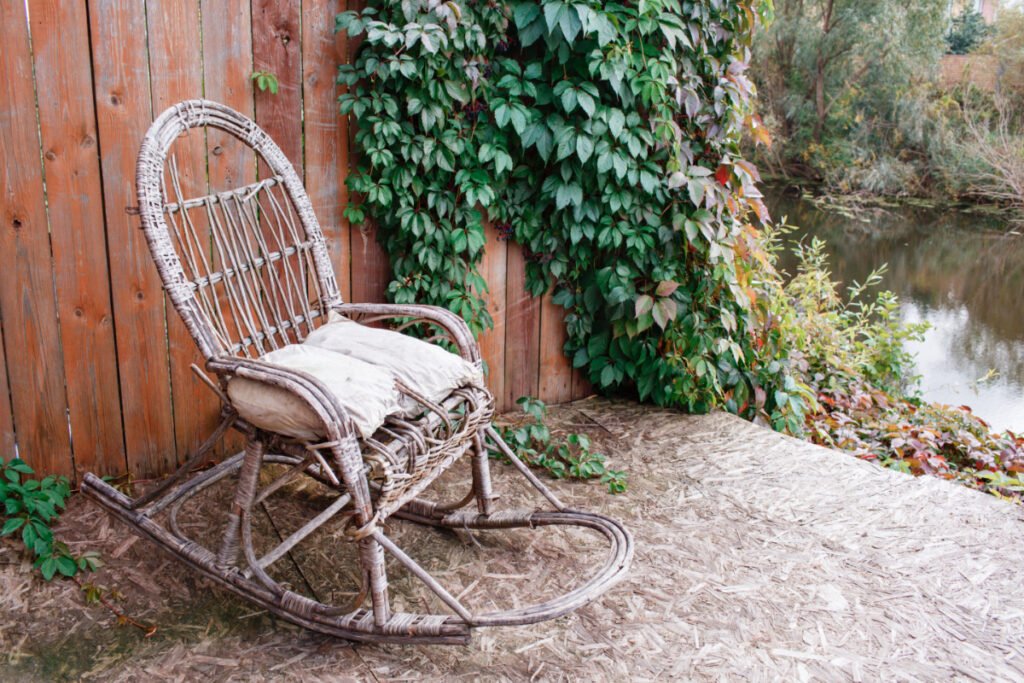
Rocking chairs’ costs vary with age. The earlier models from the 1750s are the most precious, and their value escalates more if they feature exclusive floral designs at the rails. Similarly, thick and minimal chairs from the 18th century are valuable.
In contrast, factory-made models from the late 1900s are mass-produced and easy to get. So, they don’t have high demand and may have a low value of up to $80.
- Chairs of the Early 1700s: The 1700s rocking chairs are solid-wood chairs with curved backs and rockers. But they have handmade armrests and backs with original, hand-screwed joints. So, they have a high cost of $800 – 1000.
- Chairs of the Early 1800s: The 1800s rocking chairs have carved arms, spiral legs, and curvilinear shapes, valued at about $500 – 800.
- Chairs of the Late 1850s: These chairs have pad armrests, slated backs, and thick wood sections. They are minimal in design but are heavy and durable. Depending on the brand, they may have different colors but cost roughly $300 – 500.
- Chairs of the Early 1900s: Antique rocking chairs 1900s models are factory-made. You can track their age with the stains and the product codes on the underside. But, they have low demand and a value of $100 – 120.
Here are some common product codes for quick reference:
| Year | Chair Age | Product Code | Location | Manufacturer | Valuation |
| 1900 | 123 | BO55CH | America | Boston Rocking Chair | $400 – 500 |
| 1980 | 43 | CIRCA 1980 | North Carolina | Nichols and Stone | $380 – 400 |
Always check the manufacturer’s logo on the underside of every rocking chair. Usually stamped, wax-polished chairs are older and valuable.
2. Chair Material & Wood
Old, 17th-century chairs were built from Walnut or Oak wood featuring straight grain and a dark brown to light brown hue. They may also have purple or red streaks as per age.
In contrast, 18th-century chairs are mostly made from Maple, Cherry, or Mahogany wood. So, they have a reddish texture, speckled grain, and shiny wax polish.
The later 19th-century chairs can be made from Rosewood or White Oak. So, they are white or purplish and have beautiful, unorganized grain. And they’re also very precious due to their slight scent and rich finish, costing around $300.
Lastly, 20th-century rocking chairs are more industrial and vary according to the metal. For example, copper or iron chairs are precious, but steel chairs have a low valuation.
You can find the average antique rocking chair value according to their materials below:
| Chair Material | Year | Average Valuation |
| Walnut or Oak Wood | 1700 | $500 – 600 |
| Maple, Cherry or Mahogany Wood | 1800 | $350 – 400 |
| Rosewood or Oak Wood | 1900 | $250 – 300 |
| Oxidized Copper | 1950s & Above | $250 – 350 |
| Wrought Iron Metal | 1950s & Above | $300 – 400 |
| Alloyed Steel or Spring Steel | 1950s & Above | $90 – 150 |
| Cane Metal | 1950s & Above | $100 – 200 |
Look out for solid-wood or single-grained rocking chairs. Composite wood chairs are often damaged and have an inferior finish and low value.
3. Vintage Rocking Chair Styles
Vintage rocking chairs from the early 17th and 18th centuries are more linear and inlaid. These American or Victorian-style chairs may have curvy legs and relief carvings, having a high value of $400 – 500.
Similarly, Art-Deco chairs cost more because of their geometrical and minimal designs. In contrast, German or modern rocking chairs have a low valuation due to mass production.
Check the table below for the top features and valuation of each style:
| Rocking Chair Style | Year | Top Features | Valuation |
| American or Hitchcock | 1780 | Lightweight, Thin sections, Low-relief carvings, and Inlay details | $400 – 500 |
| English or Victorian | 1720 | Curvy Design and High relief carvings | $450 – 600 |
| Bauhaus or ArtDeco | 1920 | Sleek, minimal metal sections, and leather upholstered seats | $300 – 450 |
| German or Thonet | 1950s | Bentwood rockers, Armrest pads, Factory-made designs | $65 – 120 |
Pick American or Art Deco style chairs for a vintage, classical look. But go with minimal German chairs for a modern ambiance.
4. Branding
Branded rocking chairs with a burnt logo are more valuable than local ones. These have thick solid wood construction and exclusive bird or mesh carving with a shiny polish.
Generally, these chairs were made in America, Spain, or Germany and may feature some regional birds, flowers, or monuments. Thus, they have unique, limited-edition designs and value more.
Rocking chairs with a burnt or etched company logo fetch $400 – 500, whereas unstamped ones value $60 – 70.
Here’s a list of some vintage rocking chair brands and their values:
| Chair Name | Manufacturer | Year | Material | Valuation |
| Mission-style Rocker | L and J.G Stickley | 1900 | Oak or Mahogany Wood | $3000 – 4000 |
| Carved Rocker | Charles Rohlfs | 1902 | Oak with Modern Leather | $10,000 – 12,000 |
| Barrel Rocking Chair | Plail Brothers | 1950s | Oak wood with Cotton upholstery | $1500 – 2000 |
| Egg Rocking Chair | Josef Hoffman | 1950s | Oak and Cane seats | $15,000 – 17,000 |
Pick American Boston rockers or Shaker chairs for the highest valuation.
5. Rarity

Limited-edition or handcrafted rockers with uneven surfaces and drag marks are highly-valued. These chairs use spiral legs and may have metal armrests that hike their cost. And they are maximal in style and often have visible wear and tear.
Here’s a list of rare old style rocking chairs for better identification:
| Name | Manufacturer | Year | Valuation | Material |
| Art Nouveau Swing Rocking Chair | Thonet | 1900 | $1479 | Dark Oak Wood |
| Silver Gilt Rocker | Grotto Fantasy | 1900 | $58,000 | Giltwood |
| Natural Wicker Rocker | Harbor natural | 1900 | $1000 | Reed, Wood |
| Steel-Webbed Rocking Chair | George Hunzinger | 1869 | $4500 | Walnut Wood |
Look out for steel or metal carvings to identify rare rocking chair patterns.
6. The Manufacturing Process
Hand-crafted rockers with uneven edges and chisel marks value up to $2000. They usually have straight-line cuts, geometrical motifs, and saw-cut and tapering armrests.
In contrast, 18th-century rocking chairs look refined and have smooth, machine-cut surfaces. They’re adorned with intricate mesh patterns with smaller size and grain variations. But since these are new, they only cost around $100 – 500.
Minor hand manufacturing defects like wood knots, tapered handles, or curved rockers increase the total valuation by 1 – 2%.
7. Wood Finish

Hand-polished oil, wax, or shellac stains with visible brush strokes are precious. And even new and imported varnishes are valuable due to their low availability. But rocking chairs with peeled paints and acrylic finishes are relatively cheaper.
Here’s a table to identify typical rocking chair finishes and their value:
| Finish | Year | Main Contents | Valuation |
| Oil and Wax | 1700s | Animal fat wax, Beeswax, Paraffin wax, Plant and Flower Residue | $500 – 650 |
| Shellac | 1750s | Amber flakes and Alcohol | $300 – 400 |
| Lacquer and Varnish | 1800 | Synthetic compounds and resin | $200 – 300 |
| Paints | 1850s | Oil and water-soluble compounds and colored pigments | $100 – 250 |
Oil, wax and milk finishes are old, rough and matte. But, newer varnish and paint finishes will be glossy and smooth.
8. Screws, Nails & Bolts
Old rocking chairs with blunt square nails and rough grooves are precious. But those with softer machine-made heads and threads have a lower valuation. Similarly, rockers with galvanized industrial screws and fasteners are cheaper.
Here’s a list of some screws and their average value:
| Type of Screw | Year | Key – Features | Valuation |
| Beaten Nails | 1700s | Square shape, deformed heads, and blunt tips | $15 – 20 |
| Hand-made Screws | 1750s | Square shape, Grooved surfaces and tapering tips | $10 – 12 |
| Partially Mechanized Screws | 1800s | Uniforms heads and threads, Round shape | $7 – 10 |
| Factory-made Bolts | 1850s | Round shape, Spiral grooves, and a galvanized finish | $2 – 5 |
9. Antique Rocking Chair Upholstery
Natural animal skin or leather upholsteries with original tufted backs are extremely precious. And newer satin, silk, or stapled fabrics are cheaper and may fetch only $2 – 3 at the auction.
Similarly, sewn, inlaid, or pin-stitched rocking chair fabrics don’t value much. But original buttoned tacked or brass brad fabrics are precious.
Never buy rocking chairs with velvet or dyed upholstery, as these are new and low-valued.
Are Old Rocking Chairs Worth Anything?
Yes, old rocking chairs are precious and may fetch $400 – 500, depending on their age, finish and materials. Generally, hand-crafted chairs from the 1700s are more precious. But, even oiled Boston or Mission-style rocking chairs earn a good value.
What Is a Boston Rocking Chair?
A Boston rocking chair is a simple oak-wood chair with high, spindle backs and solid headrests. And it may have a seat, curved arms, and straight peg legs, valuing $350 – 500.
Where Do You Find Authentic Antique Rocking Chairs?
You can find rare rocking chairs on e-commerce websites like eBay, Amazon, Etsy, Wayfair, and the Vatican. Or, you can even visit your local antique stores and auctions for more items.
Old rocking chairs are extremely precious and long-lasting heirlooms. But you can monetize them based on the wood, finish, and joinery used. And stamped logos, fabrics, and finishes will help you identify and track them better.
Generally, dark walnut or oak wood rockers are precious and add a lovely colonial look to your patio. But these rockers will look even better with Antique teddy bears! But how do you know if a teddy is antique? Jump to our guide on ‘antique teddy bears’ to know more.
Note: This article is intended for informational, educational, and entertainment purposes only. Some images are illustrative and may not represent actual brands, products, or related entities. All trademarks, product names, brand logos, packaging, and other intellectual property referenced remain the exclusive property of their respective owners. Any brand mentions or references are provided solely for descriptive and educational context and do not imply any formal or commercial association.







